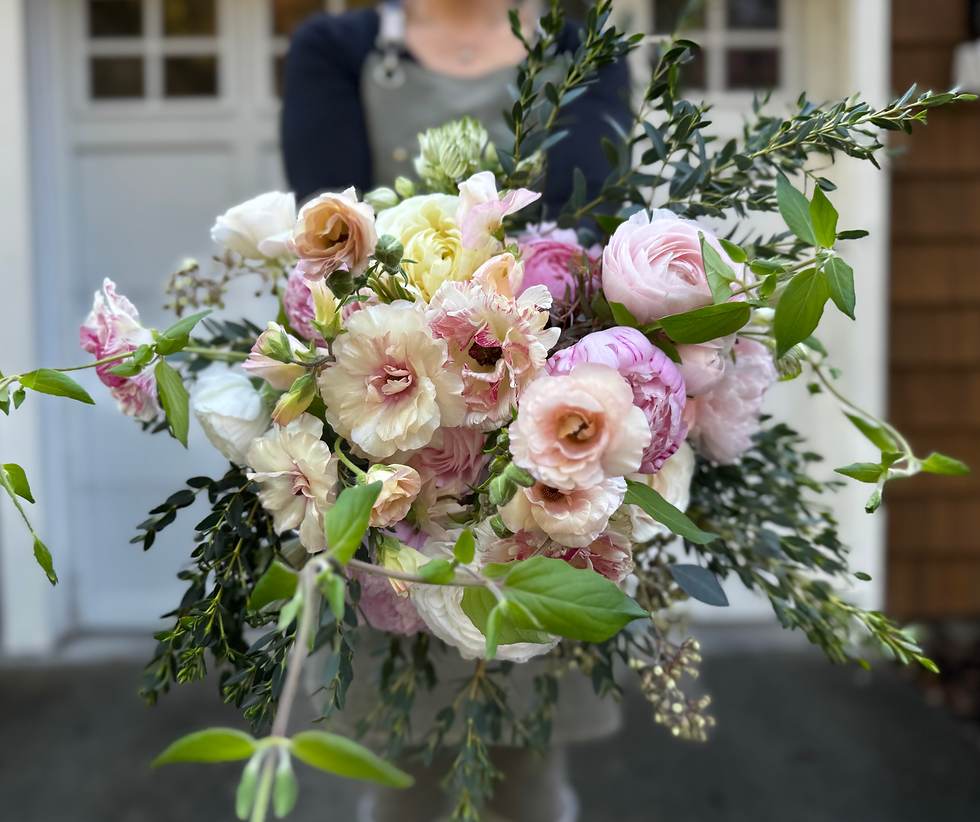How to plant Ranunculus and Anemones
- Charmaine Turbow

- Sep 2, 2024
- 5 min read
THIS IS A FALL/AUTUMN GARDEN ACTIVITY!!
Get ready to dig along in the dirt with us for some beautiful Spring blooms!!

Ranunculus and Anemones are two of our most favorite Spring blooms here at the farm. Ranunculus, also known as “Spring roses,” are exceptionally prolific when it comes to stem counts per plant. Anemones offer a beautiful contrast to ranunculus in both shape and form. Both have excellent vase life, making them most sought after cut flowers.
SO WHICH WAY IS UP AND DOWN?
My kids describe Ranunculus as miniature octopi. :) Just remember when it comes to planting time, "legs go down!"
Anemones look like odd shaped acorns. Just remember when it comes to planting time, the point goes down! (Some anemones are so oddly shaped that it's often hard to distinguish which end is up. Don't hurt your brain over it. Mother Nature will figure out which end is up!)
SIZE DOES MATTER! (for the most part)
When it comes to ranunculus and anemones, as a general rule the larger the corm size, the more robust they will be. Corms can come in varying sizes and are categorized as 2/3, 3/4, and 5/7.
When it comes to retail selection, you will be beholden to whatever is available. Retailers often don't specify size, and unfortunately, most corms sold are on the smaller side 2/3 to 3/4 size. If you happen to stumble upon small corms, just expect smaller sized blooms and/or smaller quantities of blooms per plant. The exception to this rule is with Butterfly ranunculus. These corms (across the board) are substailly taller and larger than conventional ranunculus.
To PRE-SPROUT or not to PRE-SPROUT?
What is pre-sprouting? Pre-sprouting is a step where corms are soaked, drained, and then transferred to soil where they cozy in and sprout within 14 days.
Some growers prefer not to pre-spout as it is an extra step. When growing on a large scale, losing a few corms to rot here and there or having a few non-viable corms won't make a hill beans of a difference.
However, here at our microflower farm, every bit of space counts!!! By taking the extra step of pre-sprouting all our ranunculus and anemone corms we have visability the # of plants we have available to go into our planting areas and no blank spaces! As the pre-sprouting process allows for root development, there is a lower risk of the plant rotting out due to overly wet conditions that can happen with unpredictable Fall weather.
HOW TO PRE-SPROUT CORMS
Simply soak your corms in fresh, tepid water for about 3 hours. We flush our corms with fresh water every hour to make sure there is good oxygenation! Be sure to set your timer and not oversoak your corms as that can promote rot.
While your corms are soaking prepare trays for pre-sprouting. Simply fill trays with drainage holes or tubs with about a 1” layer of soil.
Prepare labels. LABEL, LABEL, LABEL your varieties!
Remove your corms from water. (use a kitchen strainer.)
Place your ranunculus or anemones “legs/point down into the soil of your prepared trays. Cover over with lightly moistened/fresh garden soil.
Place your trays in a sheltered area with cool consistent temps of about 50F.
We place our trays/tubs in our garden tents where they are protected from vermin. By doing so, they are exposed to the low temperatures of Fall (low 40s to 50s). In about 12-14 days, your ranunculus should start to set roots and your ranunculus will start to sprout.
(L: Soaking corms R: 12-14 days later, corms have sprouted)

Head Farmette secret
USE YOUR FLORAL FRIDGE. Whether you're up against the elements of Mother Nature, or your planting space is not prepared, you can stall your corms by a week or two simply byplacing them in a floral fridge and set the temperature to low 40s. Since we don't water in our trays or tubs, it's fairly safe to put a lid over the tubs to maintain humidity and avoid rot.
PREPARE YOUR SOIL
Ranunculus and Anemones will perform well and tolerate the wet winter months with well draining, nutrient soil.
Be sure to prepare your soil appropriately by ammending your soil with a broad spectrum, nutrient rich fertilizer like Down to Earth's Biolive and turn in a good layer of Earth worm castings. Ranunculus and Anemones can overwinter easily provided you have good draining soil. To improve drainage, add perlite or soil draining materials such as lava rock as needed.
WHEN TO PLANT YOUR CORMS & SUCCESSION PLANTING

Depending on temperatures, it takes approximately 90 -120 days for ranunculus and anemone corms to bloom. Of course, prolonged dips and rises in temperature will affect bloom time.
Eg. With relatively mild winter temperatures in zone 9b, we start our first round of ranunculus and anemone corms in late October (with the pre-sprouting process) and plant in mid November. With cooler temperatures over the winter months, we find our ranunculus and anemones to have plump buds and ready to open by mid-late February.
We start a second succession in late December/January and those plants are blooming by mid March.
As long as temperatures remain cool, we can expect to have a stretch of blooms from March thru Mother's Day.
HOW TO PLANT YOUR CORMS
If you have skipped the pre-sprouting step, you can go ahead and plant your corms directly into your planting space when as long as ground temperatures are well above freezing. Our temperatures in zone 9b are relatively mild and our Fall temperatures hover in the mid 40s to high 50s.
If you have pre-sprouted your corms, gently separate the roots of your corms and plant them into your soil. Both ranunculus and anemones are pretty tough and tolerant to being handled even with young established root structures.
Plant your corms about 3" deep and cover over with your soil. (It is fine to cover over any green sprouts for pre-sprouted corms as they will make their way above soil level over the next several weeks.)
If you have smaller sized corms, you can go with a closer plant spacing of 4-5". If you have larger sized corms or butterfly ranunculus, plant at 6-9" of spacing.
PROTECT YOUR CROP
When planting in ground, we like to protect our corms with row cover cloth through the winter months. The cloth also deters vermin such as wild rabbits that like to gnaw on the young ranunculus. (yes-- those bunnies like to get drunk off of ranunculus leaves!)
WHAT TO EXPECT --SHORT STEMS! WHAT IS GOING ON??!!!
Usually the first round of ranunculus and anemone are short stemmed. Simply harvest them and enjoy. DO NOT FRET and BE PATIENT!
As temperatures start to warm in late February and March, your flush of ranunculus and anemones will stretch and you should be rewarded with a beautiful bounty!
















Comments